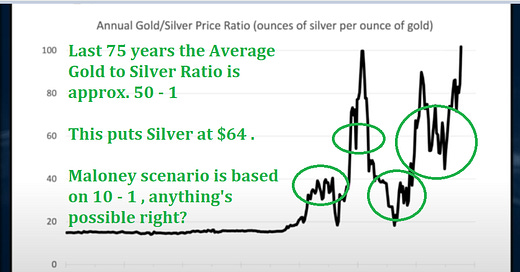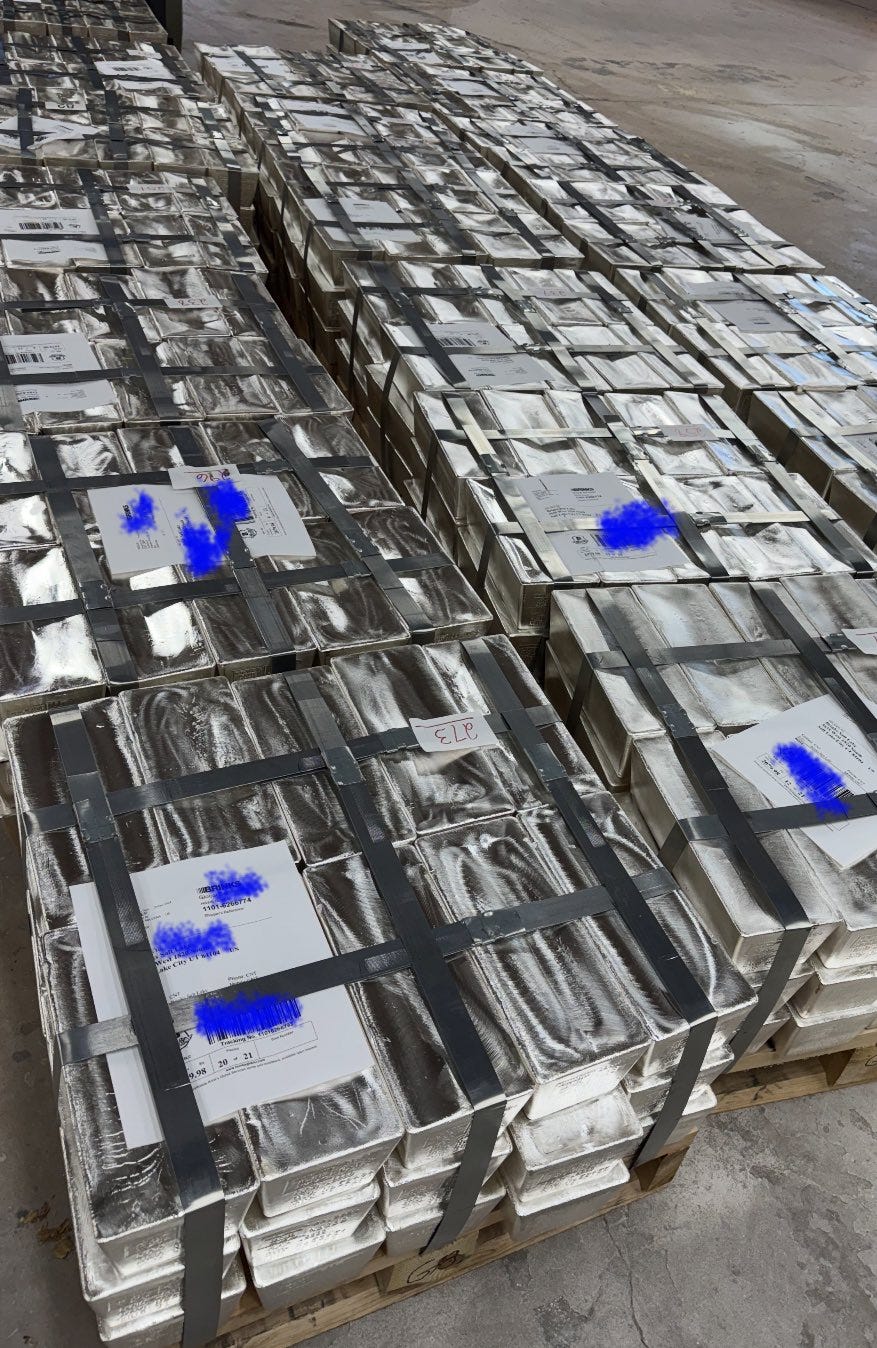Mike Maloney & Eric Sprott: Surge in Monetary demand Shrinks Gold to Silver Ratio. 20 to 1 in play.
World Debt Levels will be the Catalyst.
Mike Maloney wrote:
Then an astute follower states
The Case for $300 Silver: Mike Maloney’s Scenarios
Mike Maloney, a globally recognized precious metals analyst, has long argued that silver is not only undervalued but also poised for an explosive price move. In his recent analyses, Maloney lays out several scenarios that could realistically propel silver to $300 an ounce-a nearly tenfold increase from current levels. Here’s a breakdown of his case:
1. The Gold-Silver Ratio and Historical Undervaluation
Maloney emphasizes the extraordinary gold-silver ratio, which recently exceeded 100:1-a level seen only a handful of times in the past 2,500 years.
Historically, such extremes have preceded massive outperformance by silver relative to gold. Maloney points out that during previous precious metals bull markets, when gold became perceived as expensive, investors shifted en masse into silver, causing its price to surge rapidly. In the 1980 run-up, for example, the ratio collapsed from 50:1 to 14:1, and silver dramatically outperformed gold. Today’s even wider ratio, he argues, sets the stage for an even more explosive move if monetary demand returns.
2. Technical Patterns Pointing to a Breakout
Maloney also highlights technical chart formations, particularly the multi-decade “cup and handle” and “inverse head and shoulders” patterns in silver. These are classic bullish signals, and Maloney notes that the current cup and handle stretches back 45 years.
While technical analysis is not infallible, such long-term formations often precede major price breakouts. Maloney and other analysts see these patterns as supporting a scenario where silver could reach triple digits, potentially between $150 and $500 per ounce.
3. Monetary Demand and Public Participation
A critical trigger, according to Maloney, is a surge in monetary demand. Currently, both gold and silver are under-owned by the public and largely ignored by mainstream financial advisors, who typically recommend zero allocation to precious metals. Maloney believes that when gold becomes expensive enough-perhaps at $5,000, $8,000, or $10,000 per ounce-the public will turn to silver as the affordable alternative. This mass movement, or “public rushing in,” could drive silver to $300 or higher, especially if it coincides with a crisis of confidence in fiat currencies.
Recall my article yesterday on currency crisis and the falling US dollar.
4. Supply Constraints and Short Squeeze Potential
Maloney has also pointed to the growing mismatch between “paper” silver (futures and ETFs) and the available physical metal. With multiple traders staking claims on the same ounce of silver and a surge in short selling, there is potential for a historic short squeeze. If investors lose confidence in paper claims and demand physical delivery, the resulting scramble could send prices soaring.
Read here about David Bateman who recently “stood for delivery” purchasing 12.7 Million ounces of Silver
Bateman’s Impressive Silver Stack. David Bateman (a tech billionaire) stands for delivery stating if 3 or 4 others (billionaires, institutional funds, nations) follow his lead it will send “silver skyrocketing to the stratosphere”
5. Economic Slowdown and Industrial Demand
Finally, Maloney notes that silver’s supply is largely a byproduct of base metal mining. In a global economic slowdown, base metal production could fall, tightening the silver supply just as monetary demand spikes. This supply-demand crunch would amplify any price move.
Conclusion
Maloney’s $300 silver scenario is not based on a single catalyst but rather a confluence of historical, technical, and macroeconomic factors. If even a few of these align-such as a spike in monetary demand, a technical breakout, and a supply squeeze-$300 silver, in his view, is “entirely possible”. As with all investments, timing is uncertain, but Maloney’s analysis suggests that the ingredients for a historic silver rally are already in place.
The Leverage angle & Disappearing “Silver Only” miners.
Over the past year, the silver mining sector in Mexico has seen a wave of consolidation that’s steadily reducing the number of pure silver plays available to investors.
In early 2025, First Majestic acquired Gatos Silver in an all-share deal, bringing the Cerro Los Gatos mine under its control.
Just a month later, Coeur Mining completed its $1.7 billion acquisition of SilverCrest Metals, securing the Las Chispas mine
Shortly after, Endeavour Silver announced it was pivoting from Mexico altogether, selling some Mexico based assets and acquiring Minera Kolpa in Peru for $145 million.
This marked a significant strategic shift, allowing Endeavour to diversify its risk and tap into Peru’s prolific silver belt.
Now, in May, Pan American Silver acquired MAG Silver in a $2.1 billion deal, consolidating ownership of the Juanicipio mine
What’s important to note is that every time a silver-only mining company is acquired by a larger, more diversified miner, shareholders lose their direct, “pure play” exposure to silver.
This is particularly significant now, with the gold-to-silver ratio still hovering around 100:1-an historically high level that suggests silver is undervalued relative to gold. On top of that, silver is in its fifth consecutive year of structural deficit, with industrial demand consistently outstripping new mine supply. There’s even less silver above ground than gold at this point, making it an increasingly scarce resource.
With each of these consolidations, the number of true “silver-only” mining companies shrinks.
This is insane but there are only 5, maybe 6 Silver Only Miners remaining (not counting the ones in China, Poland, Russia that are not traded on stock exchange, recall countries like China **do not allow for the export of silver precisely because they understand the true value)
The few that remain: (These are mines in production and thus have made it past all the obstacles facing miners today such as exploration, raising capital, permitting, etc)
Andean Precious Metals (Potosi, Bolivia)
Aya Gold & Silver (Morocco)
Kuya Silver (Peru)
Endeavour Silver (Mexico and Peru)
*GoGold (Los Ricos project in Mexico)
Guanajuato Silver (Mexico)
These becoming rare opportunities for investors who want direct leverage to Silver’s price (pending explosion to the upside)
Legendary resource investors like Eric Sprott, Jim Rogers, Rick Rule, and Mike Maloney have long argued that the gold-to-silver ratio will quickly narrow.
When that happens, these remaining pure Silver plays will deliver outsized returns, offering unique and concentrated exposure to Silver’s upside that’s becoming harder and harder to find.
Editor Note:
* GoGold Resources’ current production is primarily weighted toward gold and base metals. However, their main silver-focused asset is the Los Ricos project. According to statements made by the CEO at PDAC, he is confident that the company will secure the necessary permits for Los Ricos South, with expectations for approval in the near future.
It is important to note that Mexico remains under our jurisdictional watch due to recent regulatory changes, a left wing Morena party that states the resources of Mexico belong to the people of Mexico and ongoing uncertainty in the permitting environment. Los Ricos south is designed as an underground mine (thus more greenlighted) whereas Los Ricos North is designed as an open pit (thus more obstacles)
Additionally, GoGold is reporting an all-in sustaining cost (AISC) of $12 per ounce for Los Ricos. Based on my calculations, this figure may be underestimated, as AISC often excludes prior expenditures on exploration and development, which can significantly impact the true cost of production. Moreover, the Morena party is working hard to raise wages for miners.
**Regarding the paragraph above about China silver mines being off limits I did find an exception.
Silvercorp Metals Inc. is currently the only option for US investors seeking direct exposure to Chinese silver mining operations via US markets. Given the trade war between US and China you don’t have to be a rocket scientist to understand the risk involved.







